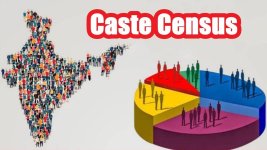
In a nation where your surname can direct your openings, where your caste is still whispered or shouted into decision-making rooms, the request for a Caste Census isn't fair a arrangement issue. It's a reflect to the breaks weave painted over with mottos of equality.
And presently, with political parties abruptly woke to caste substances, the address isn't whether we require a caste census , but why presently? And who really benefits?
Let's rewind.
The final full caste census was conducted in 1931 yes, when India was still beneath British run the show. The Socio-Economic and Caste Census (SECC) in 2011 maintained a strategic distance from distributing nitty gritty caste information, citing inconsistencies.But let's be genuine a few irregularities are fair as well politically badly designed to correct.
Cut to 2023_24. Bihar's Nitish Kumar government discharged the long-awaited caste-based study, uncovering that OBCs and EBC's make up over 63% of the populace. The stun? That most of India's populace might not indeed be appropriately spoken to in positions of control, policymaking, or open administrations. The response? A national political tremor.
Suddenly, national parties recalled the "Bahujan" in their manifestos.
While Congress swore a national caste census in its 2024 pronouncement, BJP played a calculated hush card every so often supporting sub-categorisation, whereas separating itself from the "quantity vs justify" wrangle about. But behind this quiet lies a more profound distress: recognizing caste substances implies modifying how the pie is sliced.
And that's where it gets tricky.
Because what in case the genuine fear isn't almost the complexity of information, but the danger it postures to existing control structures?
Imagine this: In case information uncovered how forward castes hold a unbalanced share of employments, riches, and impact, it might legitimize a genuine redesign of reservations, representation, and indeed budget assignment. That's not fair measurements that's a storm.
But here as the paradox.
Caste exists all over, from marital advertisements to tip top colleges. However when we inquire for information to settle the bad form, we're told it might divide society. As in case society was not as of now partitioned discreetly, institutionally, systemically.
So what may be a caste census at that point a apparatus of equity, or fair a pre-election drumbeat?
Lets be fair. Political parties will utilize it. They continuously do. But that does not cruel the request is off-base. Information is control. And for the marginalized, it's almost time they held the pen.
Let the information come. Let the truth unfurl indeed on the off chance that its badly designed. Particularly on the off chance that it is.
Because you can't settle what you deny to number.
